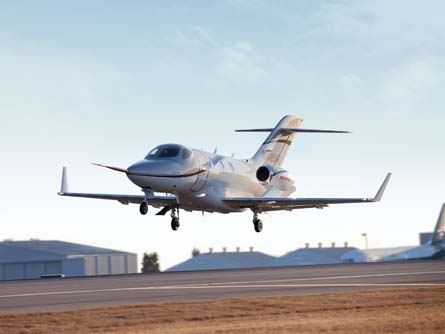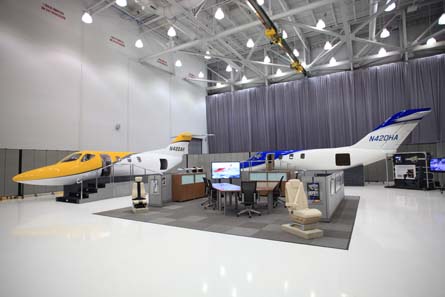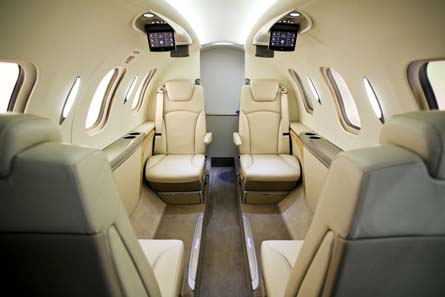Compared with most business aircraft manufacturing start-ups, Honda Aircraft has always enjoyed one overwhelming advantage - the financial backing and engineering strength of the one of the world's largest automobile companies. To the aviation world, however, this advantage has only been seen in the form of Honda's patience.
Contemporary start-ups rooted in the late 1990s, such as Visonaire, Elicpse and Adam Aircraft, were forced by financing requirements to move aircraft into a flight test phase with relative speed. By contrast, the HondaJet HA420 programme has moved with a far more deliberate pace.
Six years passed between project launch in 1997 and first flight of a proof of concept HondaJet on 3 December 2003. At that time, the company officially regarded the proof of concept as a research project. A production aircraft programme was launched three years later. Now, nearly eight years after first flight, the company is finally approaching entrance into certification testing, with first delivery scheduled in the third quarter of 2012.
 |
|---|
© Honda Aircraft The FAA is to commence certification tests of the HA420 by year-end |
In this long gestation process, the attributes and the uniqueness of the HA420 have always been visible. The aircraft's unusually tapered nose, bulbous cockpit windows and over-the-wing engine nacelles are signposts, suggesting decades of research, analysis and testing of this combination of novel aerodynamic and propulsion techniques.
Less visible has been the signs of the infrastructure required to make this five-seat, twin-engined jet a reality beyond the development and flight test phase.
Honda Aircraft officials have not been shy about expressing their plans for a successful production run. The company has outlined plans to ramp-up production to between 70 and 100 aircraft within three years after first delivery. A stretch model could enter development just as quickly, with an upgraded version of the General Electric/Honda HF120 turbofan powering the new model. It is a commitment on a grand scale, requiring massive up-front investment. Until recently, Honda Aircraft had preferred to keep its production facility hidden, allowing only its growing number of employers and suppliers and a handful of select visitors to enter its new factory complex in a remote corner of the Piedmont-Triad International Airport in Greensboro, North Carolina.
EYE OPENER
On 12 July, Honda Aircraft decided it was time to show the public - and the aerospace industry - how serious it really was. Its 48,200m2 (519,000ft2) campus was opened to local and aerospace journalists. It was the first time the facility had been glimpsed by the aviation media - and it was eye opening.
Driving on to the factory campus, one enters a public parking lot that anticipates no shortage of visitors. As flight tests continue, production work at the factory remains minimal. Of the roughly 365 parking spaces available on the main lot, more than half were empty on this particular day. Dozens more parking spaces, meanwhile, ring three buildings of Honda Aircraft's campus.
 |
|---|
© Honda Aircraft Inside the factory walls, the size and scale of Honda's investment in an unproven aerospace product is startling |
Inside the factory walls, the size and scale of Honda's investment in an unproven aerospace product is startling. By accident, the Greensboro factory is nearly complete well in advance of Honda Aircraft's need. The company's original plan called for delivering the first aircraft last year, and ramping up to 70 aircraft this year. However, problems with undisclosed suppliers - in true Japanese style, Honda Aircraft prefers to avoid embarrassing struggling industrial partners - delayed first delivery to the third quarter of next year, and slowed the production ramp-up to full-rate from one year to three years.
Activity will soon increase sharply with the start of certification tests of the HA420 by the US Federal Aviation Administration by end-year. In January or February, Honda Aircraft will begin subassembly of components for the first HA420 that will be delivered to customers six to nine months later, said Michimasa Fujino, Honda Aircraft chief executive.
In touring the factory halls and administrative offices, it is perhaps more interesting what one does not see. Many walls are barren. Few signs of a corporate culture are evident. Talking with factory employees reveals a diverse set of employment backgrounds. From shop workers to test pilots to tooling engineers, the company has hired from a wide pool of talent. A melting pot of aerospace manufacturers, including Sikorsky, Gulfstream and Hawker Beechcraft, are well represented. Also prominent are transplants from Honda's automotive divisions. Blending this workforce into a coherent culture is a challenge. Each transplanted aerospace worker came into Honda Aircraft with a different views of how to design and test a new aircraft. Corporately, Honda has its own culture, although some automotive traditions do not translate well into the aerospace sector.
Honda's automotive culture that mandates a cycle of continuous improvement. Honda introduces sometimes major changes in its supply chain and production system for automobiles on a regular basis.
It is a system that works well in the automotive industry but is more challenging to replicate on a similar scale in aerospace programmes. Regulation and certification standards prevent manufacturers from making wholesale changes in production without rigorous testing. Carmakers also have regulations to observe, but aerospace standards are on a different level.
For Fujino, the goal now is to find a balance between the demands of Honda's legacy culture and the reality of large-scale aerospace manufacturing. "I have to understand aerospace business and I have to implement good Honda culture," Fujino says. "We cannot change everything every day."
Honda's deliberate, patient style is most typified by the slow evolution of the HA420 design. Fujino spent more than a decade analysing the over-wing engine configuration before recommending it to a sceptical board of directors. The last known example of a similar design was Germany's 1950s-era VFW-614 regional turboprop. However, that aircraft was never intended for transonic speed regimes, where an over-wing engine mounting is expected to dramatically increase drag.
WIND TUNNEL TESTS
After years of study, Fujino determined it was possible to fly at speeds between M0.7 to M0.75 without a drag penalty. The secret involved stationing the wings at the optimal position relative to the fuselage. Fujino says he still encounters doubters in the aerospace industry but for several years he has had the wind tunnel and flight test results to back up his analysis. The over-wing engines are a key part of the HA420's unique performance characteristics. The all-composite aircraft is also designed to optimise the natural laminar flow of air over the nose, cockpit and wing, which explains the unique profile of those structures. The overall goal is to provide the roomiest cabin without penalising range, speed or lift.
Honda prefers to keep mum about most details of the HA420's design evolution, with notable exceptions. The proof-of-concept aircraft flew in 2003 with a 1,600shp HF118, which proved to be inadequate. The production programme launched in 2006 upgraded the engine. Since its launch, Honda Aircraft has only revealed performance details when the HA420 has exceeded design goals. For instance, the aircraft has increased maximum altitude to 43,000ft (13,000m) and beat the 420kt (780km/h) maximum cruise speed target by 5kt. In an interview, Fujino also confirms one design change, the fuselage length growing by 12.7cm to 15.2cm (5-6in).
 |
|---|
© Honda Aircraft |
A quick check of the company's marketing materials reveals other changes. Compared with a specification table published in 2007 by Honda Aircraft, the aircraft has changed in all three vital dimensions during the past four years. The latest specification table lists the HA420's height as 4.56m, an increase of 0.54m. The length has grown from 12.7m to 13.0m. The wingspan, meanwhile, has been trimmed slightly from 12.8m to 12.1m.
PREDICTIONS
Honda Aircraft has never released a figure for the HA420's maximum take-off weight but it is clear original predictions of take-off and landing distance proved too ambitious. The 2007 specification sheet predicted a precise take-off roll of 951m. The new table states take-off is less than 1,219m. Landing distance has also increased from 762m to less than 914m. What has never changed is the aircraft's most important statistic - range. According to NBAA standards for instrument flight rules, the HA420 is still able to move a full load of two crew and five passengers 1,180nm (2,185km).
As of July, Honda Aircraft was entering the final phase of its own flight-test programme. Scheduled tests were focused on examining performance in stalls and very low speeds.
Warren Gould, chief test pilot, formerly of Hawker Beechcraft, says: "It reminds me of a lot of airplanes, but it's really becoming my favourite. It's the easiest jet airplane I've ever landed." The flight-test team has no plans to ramp-down activity, even after the aircraft is expected to achieve certification by the FAA next year. No business aircraft manufacturer can survive for long with only a single product. Honda is one of the few aviation start-ups with the financial backing to launch a new programme before its original product is financially healthy. "I assume we're going to have another programme," says Alan Lawless, flight-test programme director.
Source: Flight International























